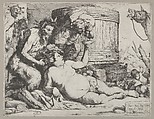Drunken Silenus holding a cup aloft into which a Satyr pours wine
Jusepe de Ribera (called Lo Spagnoletto) Spanish
Not on view
Ribera's etchings helped him to establish a reputation far beyond Naples, where he lived for most of his life. This etching is often considered his greatest. It relates to a painting he had produced two years earlier now in the Capodimonte Museum in Naples. Occupying the foreground Silenus is crowned by Pan, who is identified by his leopard skin cloak and pan pipes and staff at his feet. Silenus raises his cup to accept another drink of wine. His action is humorously echoed by the two infants at right engaged in similar activities, one of which has passed out. The braying donkey at right adds to the hilarity of the composition. For his composition, Ribera drew inspiration from the prints of other artists, including Mantegna's pair of Bacchanals (29.44.15) and Annibale Carracci's Drunken Silenus (27.78.1.150).
Due to rights restrictions, this image cannot be enlarged, viewed at full screen, or downloaded.



